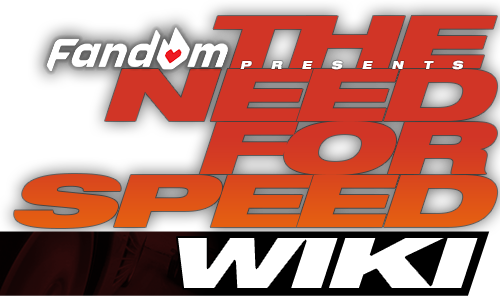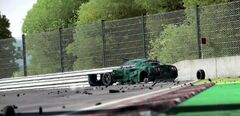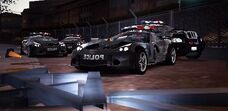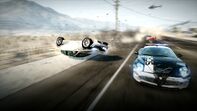mNo edit summary |
m (Game header) |
||
| Line 1: | Line 1: | ||
| + | {{Game|hs = y|pu = y|hp2 = y|mw = y|c = y|pro = y|un = y|w = y|hp10 = y|tr = y|mw12 = y|ri = y|2015 = y}} |
||
| ⚫ | |||
| + | {{cleanup}} |
||
| + | [[File:Shift 2 unleashed crash.jpg|240px|right|Damaged Lotus Exige S in ''Shift 2: Unleashed''.]] |
||
| ⚫ | |||
==''Need for Speed: High Stakes''== |
==''Need for Speed: High Stakes''== |
||
''[[Need for Speed: High Stakes]]'' is the first game in the series to feature vehicle damage, which is depicted by simple deformations on the car body. They also impact performance. |
''[[Need for Speed: High Stakes]]'' is the first game in the series to feature vehicle damage, which is depicted by simple deformations on the car body. They also impact performance. |
||
| − | Players can check the condition of their vehicle by a damage display, which shows the Engine, Steering, Body and Suspension. The intensity of damage is shown by a red barometer. |
+ | Players can check the condition of their vehicle by a damage display, which shows the Engine, Steering, Body, and Suspension. The intensity of damage is shown by a red barometer. |
| − | Car damage in career mode |
+ | Car damage in career mode can not be removed until the player has repaired them in the garage, which comes at the cost of credits. |
In the Playstation port of the game, the damage displays are not available and cars are repaired automatically after the race is finished, with a repair bill that is automatically deducted from the player's account based on the damage incurred when in career mode. Damage however still does affect performance and cosmetic appearance like it does in the PC port. For instance, flipping over damages paint, decals, panels, and removes aero parts that were installed in the stage 3 upgrade for the remainder of the race. |
In the Playstation port of the game, the damage displays are not available and cars are repaired automatically after the race is finished, with a repair bill that is automatically deducted from the player's account based on the damage incurred when in career mode. Damage however still does affect performance and cosmetic appearance like it does in the PC port. For instance, flipping over damages paint, decals, panels, and removes aero parts that were installed in the stage 3 upgrade for the remainder of the race. |
||
| Line 17: | Line 20: | ||
==''Underground'' Series== |
==''Underground'' Series== |
||
| − | Vehicles in ''[[Need for Speed: Underground]]'' and ''[[Need for Speed: Underground 2]]'' |
+ | Vehicles in ''[[Need for Speed: Underground]]'' and ''[[Need for Speed: Underground 2]]'' can not be damaged by the player, although this is possible in [[Drag]] mode. |
Totalling can happen when the player gets involved in a collision. It instantly disqualifies the player from their current race. A variant of this, known as Blown Engine, refers to the engine being overheated due to excessive over-revving. |
Totalling can happen when the player gets involved in a collision. It instantly disqualifies the player from their current race. A variant of this, known as Blown Engine, refers to the engine being overheated due to excessive over-revving. |
||
| Line 24: | Line 27: | ||
Damage in ''[[Need for Speed: Most Wanted]]'' is shown by paint and window damage, but has no effect on performance. Players can crash their vehicle in Drag mode again. |
Damage in ''[[Need for Speed: Most Wanted]]'' is shown by paint and window damage, but has no effect on performance. Players can crash their vehicle in Drag mode again. |
||
| − | [[Police]] vehicles can receive body deformations as opposed to the |
+ | [[Police]] vehicles can receive body deformations as opposed to the player's car and be totalled after taking excessive damage. |
==''Need for Speed: Carbon''== |
==''Need for Speed: Carbon''== |
||
| Line 60: | Line 63: | ||
==''Need for Speed: Most Wanted'' (2012)== |
==''Need for Speed: Most Wanted'' (2012)== |
||
| − | Crashing works very similarly to that of ''Need for Speed: Hot Pursuit'' (2010), although players who crash into an obstacle whilst playing in singleplayer mode will not be respawned in the middle of the road if they |
+ | Crashing works very similarly to that of ''Need for Speed: Hot Pursuit'' (2010), although players who crash into an obstacle whilst playing in singleplayer mode will not be respawned in the middle of the road if they are on their wheels. |
It is also possible to pop the tyres by performing a burnout or becoming involved in a devastating crash. The Reinflating Tyres [[Need for Speed: Most Wanted (2012)/Modifications|modification]] as well as Repair Shops can be used to undo the damage. |
It is also possible to pop the tyres by performing a burnout or becoming involved in a devastating crash. The Reinflating Tyres [[Need for Speed: Most Wanted (2012)/Modifications|modification]] as well as Repair Shops can be used to undo the damage. |
||
Revision as of 02:42, 28 July 2019
Several Need for Speed installments allow players to damage their vehicle, which can be done by colliding with an object. Excessive damage can lead to total damage.
Need for Speed: High Stakes
Need for Speed: High Stakes is the first game in the series to feature vehicle damage, which is depicted by simple deformations on the car body. They also impact performance.
Players can check the condition of their vehicle by a damage display, which shows the Engine, Steering, Body, and Suspension. The intensity of damage is shown by a red barometer.
Car damage in career mode can not be removed until the player has repaired them in the garage, which comes at the cost of credits.
In the Playstation port of the game, the damage displays are not available and cars are repaired automatically after the race is finished, with a repair bill that is automatically deducted from the player's account based on the damage incurred when in career mode. Damage however still does affect performance and cosmetic appearance like it does in the PC port. For instance, flipping over damages paint, decals, panels, and removes aero parts that were installed in the stage 3 upgrade for the remainder of the race.
Need for Speed: Porsche Unleashed
The damage system was retaken unchanged by Need for Speed: Porsche Unleashed from the previous title. The damage display was changed with a car rendering, which is green by default. Damaged car parts are displayed red.
Need for Speed: Hot Pursuit 2
Visual damage is possible in Need for Speed: Hot Pursuit 2, but mechanical damage does not appear in this title.
Underground Series
Vehicles in Need for Speed: Underground and Need for Speed: Underground 2 can not be damaged by the player, although this is possible in Drag mode.
Totalling can happen when the player gets involved in a collision. It instantly disqualifies the player from their current race. A variant of this, known as Blown Engine, refers to the engine being overheated due to excessive over-revving.
Need for Speed: Most Wanted
Damage in Need for Speed: Most Wanted is shown by paint and window damage, but has no effect on performance. Players can crash their vehicle in Drag mode again.
Police vehicles can receive body deformations as opposed to the player's car and be totalled after taking excessive damage.
Need for Speed: Carbon
Need for Speed: Carbon uses the same damage system from Most Wanted. Although not referred to as totalled, the player can be disqualified by falling off a canyon cliff.
Need for Speed: ProStreet
A car can become totalled in any event in Need for Speed: ProStreet, either by taking excessive damage or having a flip over. A totalled vehicle is ineligible for any race event until it is repaired with the usage of a Total Repair Marker.
Need for Speed: Undercover
Cars in Need for Speed: Undercover can become totalled through excessive damage in a story mission or in Highway Battle mode.
Shift Series
Vehicles in Need for Speed: Shift and Shift 2: Unleashed get performance drawbacks upon receiving damage. When players collide at a high speed, the driver will moan and the game will briefly turn grey.
Cars can be totalled by taking excessive amount of damage. In Shift 2: Unleashed, it is possible to lose tyres.
Need for Speed: World
Vehicles in Need for Speed: World use the same damage system as seen in Need for Speed: Carbon. It is impossible for the player to total their vehicle.
Damage in World is its durability. A total loss of durability will remove the effects of all performance parts installed. To prevent this, players can purchase Insurance for 750 SpeedBoost for 1 week.
Need for Speed: Hot Pursuit (2010)
Need for Speed: Hot Pursuit (2010) features visual damage, which does not affect performance.
Players can crash their vehicle in any game mode including free roam mode. A short cutscene (referred to as "Crashed") showing the player crashing into an obstacle will be displayed upon colliding with a traffic vehicle or indestructible object in the environment at high speed. They will be respawned back on the road with visual damage, which can be increased by crashing again. Crashing too many times will result in the players' car being totalled.
Cops in Need for Speed: Hot Pursuit (2010) are able to bust racers even during a crash.
Players on the side of the SCPD can cause racers to crash until their cars are totalled. This gameplay mechanism is known as Bust.
Need for Speed: The Run
Damage works in the same way as in Hot Pursuit in Need for Speed: The Run.
The "Crashed" game term is known as "Wrecked." In such event, the player has to reset the race in the last checkpoint they have passed. The amount of available resets depends on the difficulty the player is on.
Need for Speed: Most Wanted (2012)
Crashing works very similarly to that of Need for Speed: Hot Pursuit (2010), although players who crash into an obstacle whilst playing in singleplayer mode will not be respawned in the middle of the road if they are on their wheels.
It is also possible to pop the tyres by performing a burnout or becoming involved in a devastating crash. The Reinflating Tyres modification as well as Repair Shops can be used to undo the damage.
In multiplayer, the vehicle of the player will be automatically repaired after a crash.
Need for Speed: Rivals
The damage system in Need for Speed: Rivals is very similar to that of the previous game. However, the player will no longer see a "Crashed" message after crashing.
When the player's vehicle reaches below 25% durability, a Damage Critical message will appear on the screen, as well as a voice notification saying "Vehicle Damage Critical". A vehicle will be "Wrecked" ("Busted" if attacked by Redview County Police Department units) if it reaches 0% durability. Additional visual cues that show the Damage Critical state include steam coming from the engine as well as the screen becoming shrouded in a black vignette with visible scratches.
Need for Speed (2015)
Visual damage is possible in Need for Speed (2015), but mechanical damage does not appear in this title.




